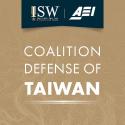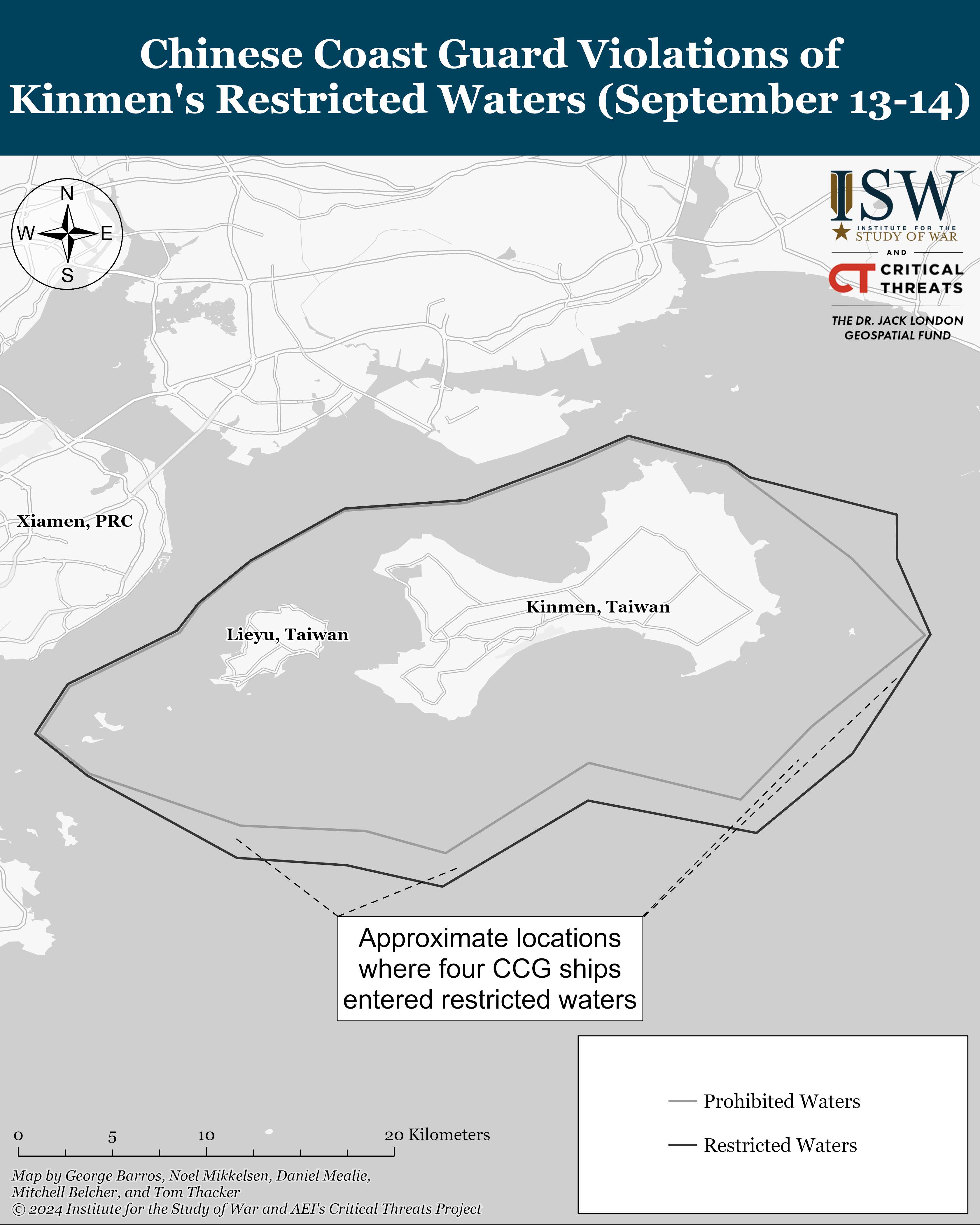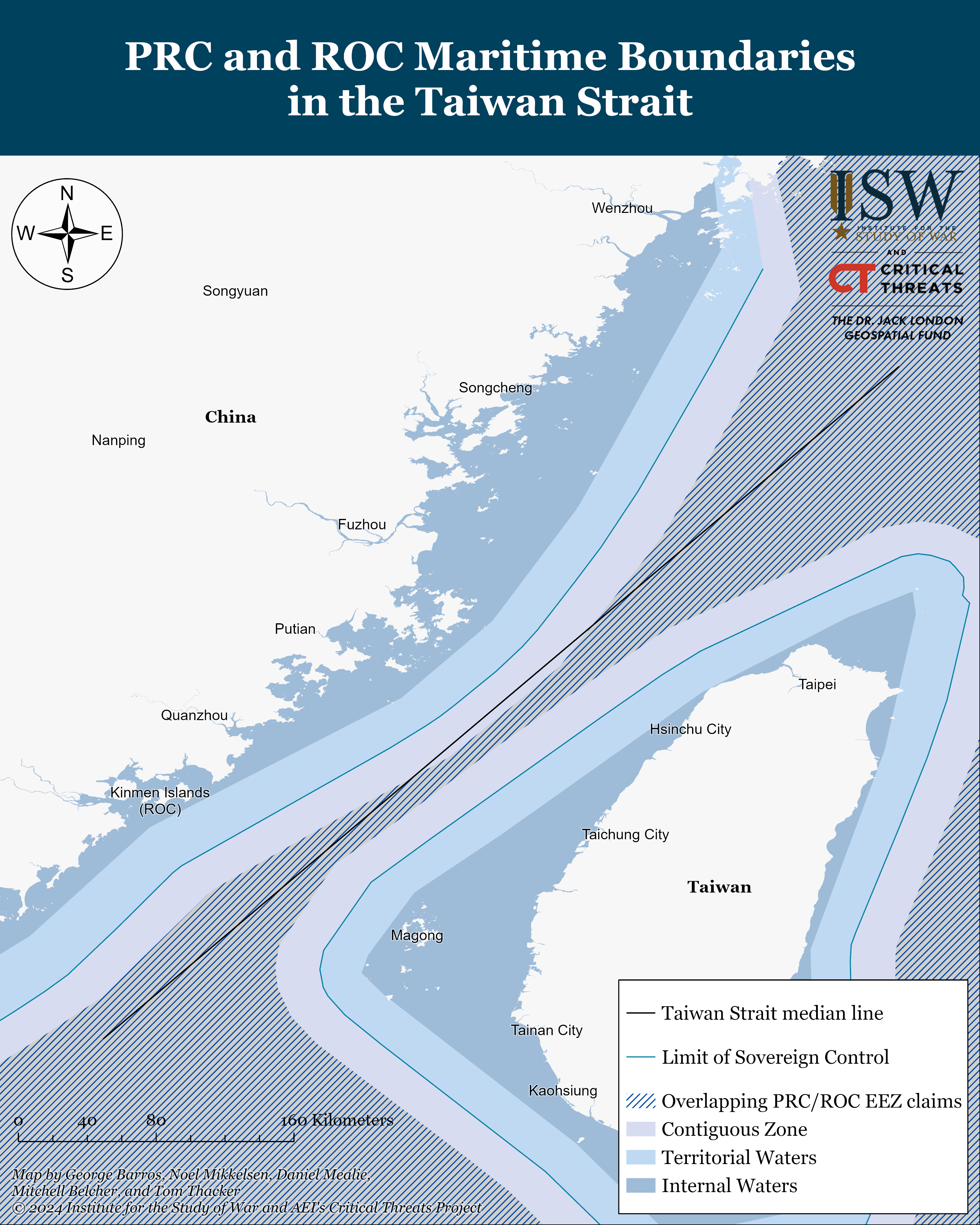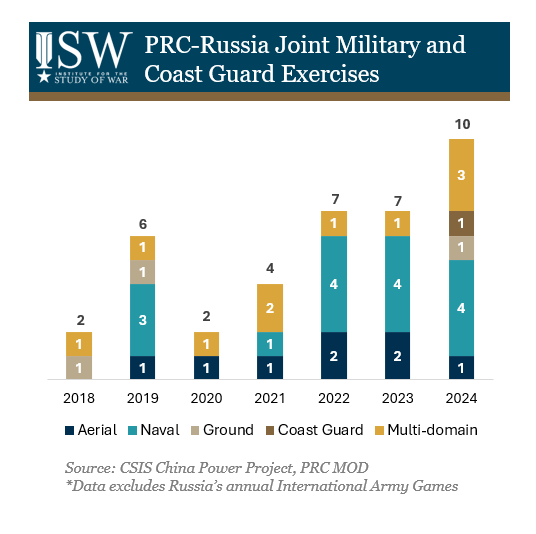 |
 |
China-Taiwan Weekly Update, September 20, 2024

China-Taiwan Weekly Update, September 20, 2024
Authors: Matthew Sperzel, Daniel Shats, and Alison O’Neil of the Institute for the Study of War;
Alexis Turek of the American Enterprise Institute
Editors: Dan Blumenthal and Frederick W. Kagan of the American Enterprise Institute
Data Cutoff: September 17, 2024
The China–Taiwan Weekly Update is a joint product from the Institute for the Study of War and the American Enterprise Institute. The update supports the ISW–AEI Coalition Defense of Taiwan project, which assesses Chinese campaigns against Taiwan, examines alternative strategies for the United States and its allies to deter the Chinese Communist Party’s (CCP) aggression, and—if necessary—defeat the People’s Liberation Army (PLA). The update focuses on the Chinese Communist Party’s paths to controlling Taiwan and cross–Taiwan Strait developments.
Key Takeaways
- The CCP framed the corruption case against Taiwan People’s Party founder Ko Wen-je as part of a “Green Terror” campaign by Taiwan’s ruling Democratic Progressive Party to persecute “dissidents.”
- Four Chinese Coast Guard ships intruded into Taiwan’s “restricted waters” around Kinmen on two consecutive days in a continuing effort to assert PRC jurisdiction over the waters.
- The 2024 Beijing Xiangshan Forum points toward an increase in the PRC’s international security cooperation, most notably with Russia.
- The PRC used the BRICS high-level meeting of representatives for security affairs in St. Petersburg to promote the forum as the voice of the Global South.
- The Philippines withdrew the BRP Theresa Magbanua from Sabina Shoal following four weeks of the CCG blocking Philippine resupply missions to the Shoal. The CCG could replicate this strategy against other PCG ships, such as the BRP Sierra Madre in the Second Thomas Shoal.
Cross-Strait Relations
Taiwan
The CCP framed the corruption case against Taiwan People’s Party (TPP) founder Ko Wen-je as part of a “Green Terror” campaign by Taiwan’s ruling Democratic Progressive Party (DPP) to persecute “dissidents.” Taipei authorities detained Ko Wen-je incommunicado on September 5 in connection with a corruption case from his time as mayor of Taipei in 2014–2022. Prosecutors allege that Ko and members of his mayoral administration accepted bribes to approve the expansion of a shopping mall, which dramatically increased the property’s value.[1] Ko is the founder of the TPP, Taiwan’s third-largest political party, and was the party chair until August 29 when he announced a three-month leave over an unrelated campaign finance scandal from his 2024 presidential run.[2] CCP Taiwan Affairs Office (TAO) spokesperson Chen Binhua responded to a question about Ko’s arrest by claiming that Taiwanese public opinion believes President Lai Ching-te has been perpetrating a “Green Terror” and “using judicial means to suppress dissidents for his political interests.” “Green Terror” is a reference to the DPP’s color, green, and the “White Terror” period of martial law in Taiwan from 1947–1987.[3] The CCP is connecting the two to undermine popular support for the DPP administration by portraying the DPP as corrupt and tyrannical.
The CCP is framing the Ko case as part of the “Green Terror” likely to capitalize on sentiments among a minority of Taiwan’s population that the case against Ko Wen-je is political persecution. Support for Ko is far more mainstream in Taiwan than support for the pro-reunification activities that the CCP typically claims are being “persecuted.” The TPP accused the DPP government of politically persecuting Ko and framed the case against him as a crisis of judicial integrity. It maintains that Ko is innocent.[4] A recent poll by the Taiwan Public Opinion Foundation (TPOF) found that 28.6% of respondents agreed with the statement that the case against Ko is political persecution by the ruling party, while 54.6% disagreed.[5]
Chen also used the “Green Terror” allegation in the context of two other cases. Taiwan’s Pingtung District Court sentenced two local leaders of the fringe Reunification Alliance Party to four and a half years in prison for colluding with the CCP to interfere in Taiwan’s 2024 elections. The two men recruited people to go on “free” trips to the PRC with funding from the TAO, took the trip participants to meet with PRC officials, and urged them to vote for certain candidates outside their party.[6] Taiwan is also investigating retired general Tsang You-hsia for standing for the PRC national anthem while attending a pro-reunification event in Hong Kong. Tsang is a former chairman of the now-defunct Huang Fuh-hsing department of the Kuomintang (KMT), Taiwan’s main opposition party.[7] Chen condemned both cases as evidence of the DPP’s “Green Terror” and abuse of power. He claimed that “anyone may be the next victim” of the DPP’s “plot” to persecute supporters of “cross-strait exchanges.”[8]
The CCP reiterated that its measures against Taiwanese “separatism” target only a very small minority of “‘Taiwan independence’ diehards” and will not affect the vast majority of the Taiwanese people who live, work, or travel in the PRC. The PRC issued new legal guidelines on the punishment of Taiwanese “separatists” on June 21 which recommended severe punishments up to the death penalty for activities that promote Taiwan’s independence.[9] It established an email mailbox for reporting such “separatist” activities on August 7.[10] TAO spokesperson Chen Binhua said on September 11 that PRC authorities would carefully verify and identify any tips it receives through the mailbox and crack down on the “very small number of ‘Taiwan independence’ diehards and their separatist activities.” Chen denied Taiwanese media reports that some Taiwanese businessmen in the PRC were reported through the mailbox and harassed and that many of them left the PRC. He claimed the media reports had “ulterior motives” to deceptively conflate the vast majority of Taiwanese people with separatist “diehards” and “muddy the waters.” He encouraged more Taiwanese people to visit the PRC and claimed that the 2.6 million Taiwanese who visited the PRC from January to August of 2024 were a repudiation of the “lies and rumors” of the DPP.[11]
Four Chinese Coast Guard (CCG) ships intruded into Taiwan’s “restricted waters” around Kinmen on two consecutive days in a continuing effort to assert PRC jurisdiction over the waters. Four CCG ships simultaneously entered four different locations in the restricted waters around Taiwan’s Kinmen island group on September 13 and again on September 14. They entered at 8:50 am and left at 11 am on both days. The CCG did not announce the incursions. Taiwan’s Coast Guard Administration (CGA) accused the PRC of deliberately carrying out these incursions on the eve of the Mid-Autumn Festival, a major holiday on both sides of the Taiwan Strait that occurs on September 17. The CGA said the incursions were the first in September and the 39th and 40th of 2024.[12]
Kinmen is located less than two miles from the PRC mainland city of Xiamen. Taiwan does not claim any territorial waters around Kinmen but maintains concentric “prohibited” and “restricted” zones around the islands that are functionally equivalent to territorial waters and a contiguous zone. This means that Taiwan reserves the exclusive right to conduct law enforcement activities there. The PRC largely respected these maritime boundaries before 2024 even if it did not officially acknowledge them.
The CCG has normalized incursions into the restricted waters around Kinmen since February 2024 to erode Taiwan’s control over the waters and establish the PRC’s legitimate right to enforce its laws there. The CCG has conducted incursions into the waters an average of five times per month. Some of the patrols ventured into Kinmen’s prohibited waters as well. The PRC began these efforts in response to an incident in February in which two PRC fishermen died in a boat collision while fleeing a CGA pursuit in Kinmen’s prohibited waters. The number of monthly incursions peaked in May around Taiwan President Lai Ching-te’s inauguration, and the PRC has gradually increased the duration of each incursion from around one hour to over two hours. The PRC has also expanded the patrol scope from fixed-line patrols in formation to a broad patrol area where individual CCG ships can patrol freely. PRC officials have repeatedly denied the existence of restricted or prohibited waters around Kinmen since February, most recently during a TAO press conference on September 11.[13] PRC state-affiliated social media account Yuyuan Tantian suggested that the “Kinmen model” of normalizing “law enforcement” patrols can be applied to other Taiwanese outlying islands in the future, such as Matsu and Penghu.[14]
The PRC objected to the transit of German warships through the Taiwan Strait on September 13. The PRC claims jurisdiction over the entire Strait and denies the existence of “international waters” in the Strait. The German naval frigate Baden-Wuerttemberg and the supply ship Frankfurt am Main transited the Taiwan Strait en route from South Korea to Indonesia. This was the first time German warships transited the Taiwan Strait in 22 years. German Minister of Defense Boris Pistorius said the Taiwan Strait is an international waterway and was the shortest and safest way to the ships’ destination.[15] The PLA Eastern Theater Command (ETC) organized air and naval forces to monitor the ships’ transit. PRC officials framed the transit as a provocation. PRC Ministry of National Defense (MOD) Spokesperson Col. Wu Qian said that “freedom of navigation does not mean freedom to run rampant and it cannot be used to provoke and endanger [the PRC’s] sovereignty and security.”[16] Ministry of Foreign Affairs (MFA) Spokesperson Mao Ning said that the Taiwan issue is not about freedom of navigation but about the PRC’s “sovereignty and territorial integrity.” She said that the PRC respects “the navigation rights enjoyed by all countries in relevant waters in accordance with Chinese law and international law, including the United Nations Convention on the Law of the Sea” (UNCLOS), but firmly opposes “provocation and endangerment of China's sovereignty and security under the banner of freedom of navigation.”[17]
The PRC claims varying levels of jurisdiction over the entire Taiwan Strait and denies the existence of “international waters” in the Strait. It frequently protests foreign military transits through the Taiwan Strait but has not physically impeded them. The MFA claimed on September 9 that the Taiwan Strait is “China's internal waters, territorial sea, contiguous zone and exclusive economic zone in that order" when moving from either shore toward the middle.[18] This characterization includes Taiwan and its maritime jurisdictions as part of the PRC.
PRC officials have denied that the Taiwan Strait constitutes “international waters” and stressed the PRC’s jurisdiction over the entire strait, which may be intended to imply that foreign military ships should not sail there without Beijing’s permission.[19] States, including the PRC, do not have sovereign rights to deny passage to foreign ships within their contiguous zone or Exclusive Economic Zone (EEZ), however. Such regions therefore are informally called “international waters” because any ship has a right to navigate freely in those waters. States can only restrict passage in their internal or territorial waters, which extend up to the country’s territorial baseline and 12 nautical miles beyond it, respectively.
Pro-Russian hackers targeted many Taiwanese government and financial websites with DDoS attacks in retaliation for ROC President Lai’s comment about the PRC taking back parts of the Russian Far East. Lai argued in an interview on September 1 that the PRC’s intention to annex Taiwan is not truly about territorial integrity, otherwise “why not reclaim the land ceded to Russia in the Treaty of Aigun during the Qing Dynasty?”[20] The pro-Russia hacker group NoName057(16) framed Lai’s comments as a suggestion that the PRC should “take away Russia’s land in the Far East” and retaliated by launching large-scale Distributed Denial of Service (DDoS) attacks on Taiwanese government and financial websites beginning on September 9.[21] The group took down at least 45 websites by September 14. It continued to claim attacks through September 17. The group’s targets included the websites of Taiwan’s Supreme Court, the Ministry of Justice, government departments of many cities and counties, the Taoyuan city metro, Taipei International Airport, several major banks, the Taiwan Stock Exchange, and various local financial firms.[22]
NoName057(16) is a pro-Russian cyber collective that emerged in March 2022 and initially targeted Ukrainian government and media sites but has since expanded to target Western government, economic, and logistical entities, including in NATO member states.”[23] NoName057(16) relies on volunteers to conduct its cyberattacks and previously published its own crowdsourced botnet, "DDoSia," along with Russian and English language instructions for using DDoSia to conduct DDoS attacks.[24]
China
The PRC used the BRICS high-level meeting of representatives for security affairs in St. Petersburg to promote the forum as the voice of the Global South. PRC Foreign Minister Wang Yi stated during the meeting that the Global South has gained momentum in the 21st century and that it “should bravely stand at the forefront, take the initiative, and contribute positive forces to building a world of lasting peace and universal security.” Wang stressed that the PRC has always been a “natural member” of the Global South and pointed to last week’s Forum on China-Africa Cooperation (FOCAC), which the readout stated sent out a loud call for the Global South to forge ahead. Beyond the original and new members of BRICS, the meeting also featured representatives from Azerbaijan, Bahrain, Belarus, Cuba, Kazakhstan, Laos, Mauritania, Nicaragua, Serbia, Turkey, Uzbekistan, Venezuela, and Vietnam.[25]
The PRC has long styled itself as an ally of the developing world and since 2023, frequently refers to itself as a member of the Global South.[26] The PRC’s frequent use of the phrase in official rhetoric portrays the PRC as a champion of the Global South that takes the lead in advocating for and advancing cooperation.[27] The PRC framed the expansion of BRICS in 2023 as making progress in strengthening the representation of the Global South and rebuking a hegemonic world order in favor of multilateralism.[28] The expanding membership of BRICS and attendance from non-BRICS members at the PRC’s encouragement signals interest from countries that possibly view the forum as a way to increase their own participation in matters of international importance.
Wang called for advancing a multipolar world and enhancing the representation and voice of the Global South in a proposal for BRICS countries to cooperate to solve security threats.[29] Wang linked the PRC’s advocacy for political solutions to highlight the PRC-Brazil six-point consensus to resolve the war in Ukraine, which it claimed received a “wide range of positive responses.” Wang welcomed more BRICS partners to participate in the international conversation to form a consensus on how to reach a political solution for the war.
The PRC seeks for Global South countries to align with it on international security issues. PRC Special Representative for Eurasian Affairs Li Hui traveled to Brazil, South Africa, and Indonesia, countries that the PRC referred to as “important members of the Global South,” to generate support for its six-point consensus with Brazil, which the two countries released in May. The plan, which stipulates that Russia must participate in peace talks, has failed to gain traction with Ukraine, the United States, and most European countries, despite claims from the PRC to the contrary.[30] The PRC skipped a June peace summit in Switzerland in protest because Russia was not invited.[31]
Li’s trip came after statements on June 21 from then-Ukrainian Foreign Minister Dmytro Kuleba and Deputy Head of the Office of the President Igor Zhovkva that Ukraine is interested in having a “Global South” country host a second peace summit, which Ukraine aims to hold before the end of the year.[32] Ukrainian President Volodymyr Zelenskyy repeated Ukraine’s interest in hosting the next peace summit in a Global South country during an interview on August 25.[33] The PRC’s interest in generating support for its mediation of the war in Global South countries is possibly aimed at gaining recognition as a qualifying member of the Global South that is capable of hosting the summit. Alternatively, hosting the summit in a Global South country that the PRC has won favor with would extend the PRC’s influence over the next peace summit.
The 2024 Beijing Xiangshan Forum points toward an increase in the PRC’s international security cooperation, most notably with Russia. The Xiangshan Forum is a multilateral summit focused on security cooperation that began on September 13 and brought together Chinese defense leaders and their international counterparts. Over 1,800 guests from over 100 countries attended.[34] According to Xinhua, the number of participants at this year’s Xiangshan Forum has reached a new high, drawing representatives from NATO, the EU, and the Shanghai Cooperation Organization. Approximately one-third of the participants hailed from the United States or Europe, reflecting the PRC’s global reach in matters of security cooperation.[35] The sessions of the forum followed the themes of “Security Cooperation and Prosperity and Stability in the Asia-Pacific Region," "Multipolarization and the Direction of International Order," "'Global South' and World Peace and Development," and "International Mechanisms and Global Security Governance.”[36]
The meeting between PRC Defense Minister Dong Jun and Russian Deputy Defense Minister Fomin highlighted trends in PRC-Russia defense messaging — namely the growing alignment between their messaging on the Pacific. According to the South China Morning Post (SCMP), Fomin used his platform at the Xiangshan Forum to accuse the United States of fomenting instability in the Taiwan Strait. He lauded the PRC-Russia partnership but accused the US of militarization in East Asia. Russian news site TASS’ Telegram reported that “The plan for military cooperation between Russia and China includes more than 100 events this year, and their number will grow,” according to Fomin.[37] Moreover, Fomin's statements linked Russia and the PRC’s shared grievances against the West and legitimized overt collaboration. Fomin reportedly said that the Ukraine war has "reinvented modern warfare” and that Russia is "ready to share its unique experience of Western weapons with partners."[38]
Joint military exercises are one way Russia could share such information with China. Russia and China are comprehensive strategic partners and have participated in an increasing number of joint exercises during the last several years.[39] The number of PRC-Russia joint exercises has increased from 2 in 2018 to 10 in 2024. Most of the joint exercises are naval and occurred in places including the East China Sea and South China Sea.[40]
Southeast Asia
Philippines
The Philippines withdrew the BRP Theresa Magbanua from Sabina Shoal following four weeks of the CCG blocking Philippine resupply missions to the Shoal. The CCG could replicate this strategy against other Philippine Coast Guard (PCG) ships, such as the BRP Sierra Madre in the Second Thomas Shoal. The PCG withdrew the BRP Theresa Magbanua from Sabina Shoal on September 15.[41] PCG spokesperson Jay Tarriela stated that the ship left Sabina Shoal to evacuate personnel in need of medical care and concerns over bad weather and a lack of essential supplies.[42] The BRP Theresa Magbanua maintained a presence in the Shoal for five months due to concerns over the CCG presence in the area. Constant PCG presence has allowed it to monitor PRC land reclamation and island-building attempts. The PRC has repeatedly called for the PCG to withdraw its ships from Sabina Shoal. The PRC has accused the Philippines of violating PRC sovereign rights and the Declaration on the Conduct of Parties in the South China Sea, an agreement signed by the PRC and ASEAN member states in 2002. Despite the withdrawal of the BRP Theresa Magbanua, the PCG says that it will continue to deploy vessels to Sabina Shoal and assert its territorial claims.[43]
The PCG has clearly stated that its withdrawal from Sabina Shoal is not an indication that it is abandoning territory or ceding the shoal to the PRC.[44] There is no indication that the Philippines’ actions were a result of discussions with the PRC.[45] The PRC MFA and CCG have not responded to the PCG's claims that it will deploy additional vessels to the Sabina Shoal. Various PRC media outlets have published articles advocating for continued vigilance by the CCG in case of future “provocations” by the PCG, however.[46] The CCG has maintained its presence in Sabina Shoal following the PCG’s withdrawal.[47] Maintaining a presence in Sabina Shoal is advantageous for the PRC, as the Shoal’s location allows the PRC to assert its claim over the nearby Second Thomas Shoal and more easily intercept Philippine vessels attempting to access or establish a presence around other features in the South China Sea. Blocking resupply missions to PCG vessels in the South China Sea has resulted in the CCG forcing the withdrawal of foreign vessels. They could replicate this strategy against other PCG ships, including the BRP Sierra Madre in the Second Thomas Shoal, who attempt to maintain a more permanent presence in the South China Sea.
Russia
The PRC participated in joint naval and air exercises with Russia from September 10–16. The PRC Ministry of National Defense (MOD) announced on September 9 that Russia would send naval and air forces to participate in the PRC-led Northern Joint 2024 exercises in the Sea of Japan and Sea of Okhotsk.[48] Two PRC guided missile destroyers, a PRC guided missile frigate, a supply ship, and three ship-borne helicopters participated in the exercises. MOD stated that the PRC forces will also participate in its fifth joint maritime cruise with Russia as part of the Russian-led Ocean-2024 exercises, which will take place throughout the Pacific and Arctic Oceans.[49] Russian President Vladimir Putin stated that representatives from 15 “friendly” nations would observe its wide-ranging exercises during Ocean-2024, which the Russian government claims is the largest of its naval exercises in 30 years.[50]
The PRC and Russia are also increasing coast guard cooperation. The CCG announced that it signed a memorandum of understanding with Russia’s Federal Security Service (FSB) in April 2023 to strengthen maritime law enforcement.[51] The PRC announced on September 13 that PRC and Russian coast guard fleets will conduct joint patrols in the Northern Pacific, which aim to improve coordination and organization between the two countries and enhance their ability to “jointly respond to various maritime security threats.”[52]
The PRC and Russia are conducting increasingly frequent joint exercises in recent years and expanding the geographical scope of their cooperation. The two countries have now held joint exercises in at least five different parts of the world since July, including naval exercises in the South China Sea, Gulf of Finland, Sea of Japan, Sea of Okhotsk, and Northern Pacific.[53] PRC and Russian bombers entered the US air defense identification zone near Alaska for the first time together on July 24.[54] PRC and Russian naval vessels sailed together in the United States’ EEZ in international waters near Alaska in September 2022 and August 2023.[55] PRC naval ships and Russian naval ships sailed separately into the United States’ EEZ near Alaska on July 10 and September 16, respectively.[56]
[1] https://www.taiwannews.com dot tw/news/5931307
[2] https://focustaiwan dot tw/politics/202408290013
[3] http://www.gwytb.gov dot cn/xwdt/xwfb/xwfbh/202409/t20240911_12649283.htm
[4] https://www.cna.com dot tw/news/aipl/202409060098.aspx
[5] https://tw.news.yahoo.com/%E6%9F%AF%E6%96%87%E5%93%B2%E6%94%B6%E6%8A%BC-40-3-%E6%B0%91%E7%9C%BE%E8%82%AF%E5%AE%9A%E6%B3%95%E9%99%A2%E5%85%AC%E5%B9%B3%E5%AF%A9%E7%90%86-062227745.html
[6] https://www.taipeitimes dot com/News/taiwan/archives/2024/08/28/2003822894
[7] https://www.mirrormedia dot mg/story/20240903edi053
[8] http://www.gwytb.gov dot cn/xwdt/xwfb/xwfbh/202409/t20240911_12649283.htm
[9] https://www.understandingwar.org/backgrounder/china-taiwan-weekly-update-june-27-2024
[10] https://focustaiwan dot tw/cross-strait/202408080020
[11] http://www.gwytb.gov dot cn/xwdt/xwfb/xwfbh/202409/t20240911_12649283.htm
[12] https://www.cna.com dot tw/news/acn/202409130118.aspx
https://www.cna.com dot tw/news/acn/202409140082.aspx
[13] http://www.gwytb.gov dot cn/xwdt/xwfb/xwfbh/202409/t20240911_12649283.htm
[14] https://www.globaltimes dot cn/page/202405/1312167.shtml
[15] https://www.bmvg.de/de/presse/statement-boris-pistorius-litauischem-amtskollegen-5837674
[16] http://www.mod.gov dot cn/gfbw/sy/rt/16338524.html
[17] https://www.fmprc.gov dot cn/fyrbt_673021/202409/t20240913_11490398.shtml
[18] https://www.fmprc.gov dot cn/eng/xw/fyrbt/202409/t20240909_11487817.html
[19] https://www.voachinese.com/a/china-alarms-us-with-private-warnings-to-avoid-taiwan-strait-20220613/6615662.html
[20] https://www.taiwannews.com dot tw/news/5934985
[21] https://x.com/Noname05716/status/1833055102447350144
[22] https://focustaiwan dot tw/politics/202409140012
https://www.taipeitimes dot com/News/front/archives/2024/09/14/2003823756
https://x.com/Noname05716/status/1835989612805652954
[23] https://labs.yarix.com/2022/10/analysis-of-the-russian-speaking-threat-actor-noname-05716/ ; https://t.me/noname05716/527 ; https://www.csoonline.com/article/1270051/how-russias-noname05716-could-be-a-new-model-for-hacking-groups.html
[24] https://cybernews.com/cyber-war/new-undercover-intel-noname-russian-hacktivist-operations/ ; https://t.me/noname05716eng/2583
[25] https://www.fmprc dot gov.cn/chn//gxh/tyb/zyxw/202409/t20240912_11489355.html
[26] https://www.mfa dot gov.cn/web/wjdt_674879/gjldrhd_674881/202308/t20230824_11132240.shtml
http://www.news dot cn/world/2023-08/09/c_1212253996.htm
https://www.mfa dot gov.cn/wjbzhd/202307/t20230726_11117824.shtml
[27] https://www.gov dot cn/lianbo/bumen/202409/content_6974166.htm
[28] http://fec.mofcom dot gov.cn/article/xgzx/xgzxfwydyl/202408/20240803531582.shtml http://fec.mofcom dot gov.cn/article/xgzx/xgzxfwydyl/202408/20240803531582.shtml
https://www.mfa dot gov.cn/wjbzhd/202307/t20230726_11117824.shtml
[29] https://www.fmprc dot gov.cn/zyxw/202409/t20240911_11488997.shtml
[30] https://www.gov dot cn/yaowen/liebiao/202405/content_6953287.htm
[31] https://www.mfa dot gov.cn/web/wjdt_674879/fyrbt_674889/202406/t20240603_11375826.shtml
[32] https://interfax dot com.ua/news/general/995126.html
https://www.pravda dot com.ua/eng/news/2024/06/21/7461905/
[33] https://www.pravda dot com.ua/eng/news/2024/08/25/7471819/
[34] http://www.mod.gov dot cn/gfbw/jswj/16338157.html
[35] http://www.globaltimes dot cn/page/202409/1319681.shtml
[36][36][36] http://www.news dot cn/milpro/20240911/15d07d407e90418b9891a1add87fcba4/c.html
[37] t dot me/tass_agency/272381
[38] https://www.scmp dot com/news/china/military/article/3278421/us-stirring-asian-tensions-suppress-us-russian-minister-tells-china-security-forum
[39] https://edition.cnn.com/2024/09/17/china/china-russia-military-drills-analysis-intl-hnk/
[40] https://docs.google.com/spreadsheets/d/1sdoeaJUihsW6Hfj8ltFNXKoZ7tPJ8-P6xufQTelIerk/edit?gid=0#gid=0
[41] https://www.ft.com/content/c5817200-12d3-4f75-b8fe-2c221fac1517
[42] https://x.com/jaytaryela/status/1835192216618152200
[43] https://www.bloomberg.com/news/articles/2024-09-16/philippines-vows-to-return-to-disputed-shoal-after-ship-pullout
[44] https://www.reuters.com/world/asia-pacific/philippines-vessel-contested-south-china-sea-shoal-returns-port-2024-09-15/
[45] https://www.fmprc.gov dot cn/wjbxw_new/202409/t20240911_11489136.shtml
[46] https://www.globaltimes dot cn/page/202409/1319844.shtml; https://cn.chinadaily.com dot cn/a/202409/18/WS66ea7762a310a792b3abcaac.html
[47] https://www.pna.gov dot ph/articles/1233508
[48] http://www.mod dot gov.cn/gfbw/jsxd/16337146.html
[49] http://www.mod dot gov.cn/gfbw/jsxd/16337323.html
[50] https://www.cnn.com/2024/09/17/china/china-russia-military-drills-analysis-intl-hnk/index.html
[51] https://www.ccg dot gov.cn/mhenu/lbt/202405/t20240516_2230.html
[52] http://www.mod dot gov.cn/gfbw/jsxd/ly/16338290.html http://www.mod dot gov.cn/gfbw/jsxd/ly/16338290.html
[53] https://www.voanews.com/a/china-russia-exercises-aim-to-challenge-us-led-indo-pacific-coalition-analysts-say/7778700.html
[54] https://www.cbsnews.com/news/us-intercepts-russian-chinese-bombers-alaska/
[55] https://www.cbsnews.com/news/us-navy-destroyers-alaska-coast-11-chinese-russian-warships/
[56] https://www.news.uscg.mil/Press-Releases/Article/3834722/
https://www.news.uscg.mil/Press-Releases/Article/3907798/




